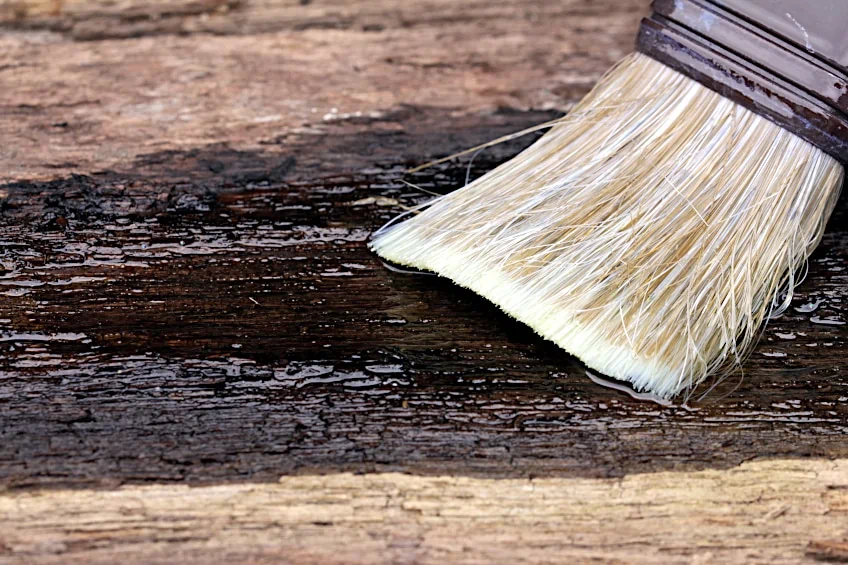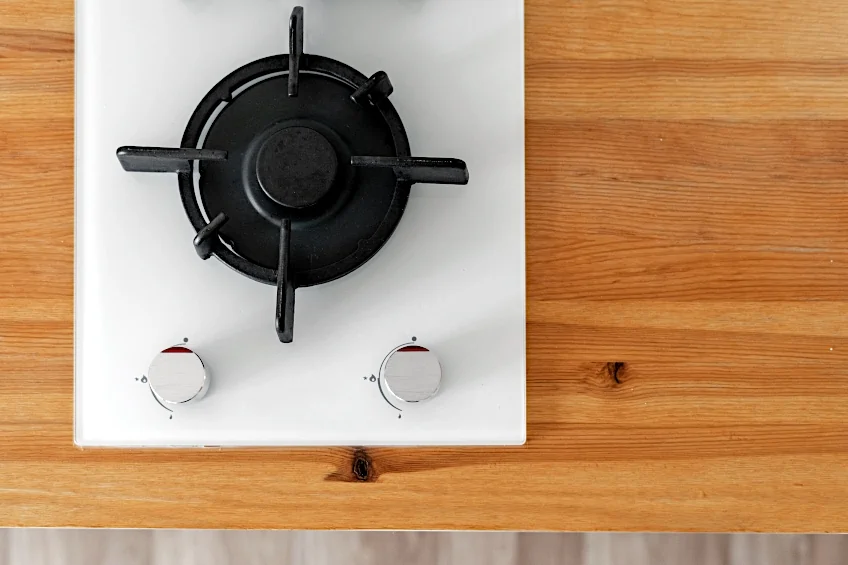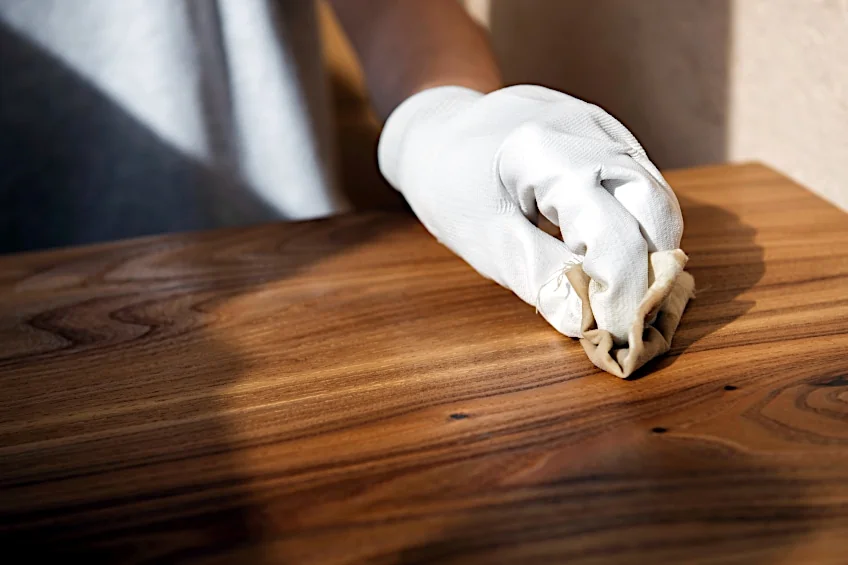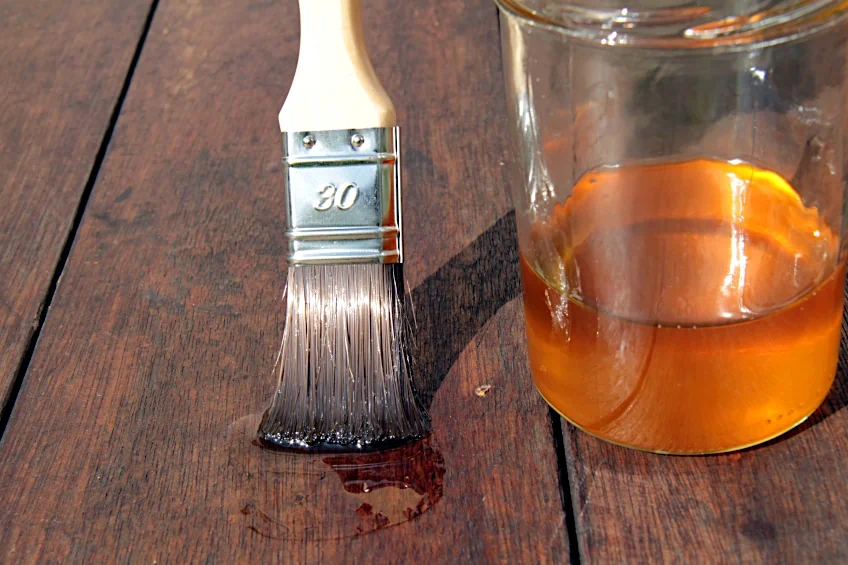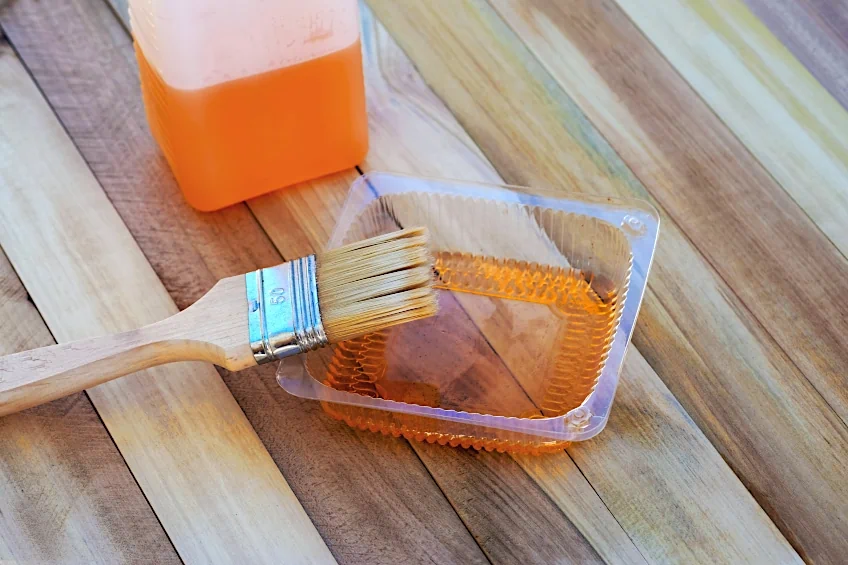How to Use Boiled Linseed Oil – Complete Guide with Images
This post may contain affiliate links. We may earn a small commission from purchases made through them, at no additional cost to you. You help to support resin-expert.com
Choosing a finish for your wooden workpiece is never easy, after all, there are so many options to choose from when trying to select a paint. However, you should keep in mind that paint isn’t your only option when it comes to finishing your wood-crafting projects. For many years a great alternative to surface coatings like paint has been the use of wood treatment oils like tung oil. These oils not only provide your workpiece with a beautiful sheen finish but are easy to maintain and can last a lifetime if maintained correctly. Of the aforementioned oils, boiled linseed is arguably among the most popular, so let’s have a look at what it is, how it differs from normal linseed oil, what it does to a wooden surface, and some other uses for boiled linseed oil.
Table of Contents
What Is the Difference Between Boiled Linseed Oil and Normal Linseed Oil?
Before we get into the difference between regular linseed oil and boiled linseed oil it’s probably a good idea if you know what linseed oil is as a substance. Linseed oil is derived from the seed of a flax plant and has been used for hundreds of years all over the work by different cultures and civilizations as a hard-wearing, reliable finish for wooden surfaces.
Linseed oil is relatively clear in appearance, but does present a yellowed tint in the presence of direct sunlight when stored in a glass container. How are flax plant seeds transformed into this oil? Well, the seeds are either squeezed or completely reduced and refined in order to make the stuff we all know and love. What are the uses for linseed oil you ask?
The uses for linseed oil cover a considerable range. Linseed oil can be used to seal concrete, as an additive in paint (hence oil-based paints), in the production of inks, soaps, linoleum, and as we all know, to treat wood, brick, and even metal surfaces. It’s pretty safe to say that this is one of the most versatile natural substances on the planet.
Linseed oil isn’t perfect though, particularly the normal kind. What are its flaws, you ask? Well, linseed oil isn’t the most robust wood treatment on the market and is easily scratched and damaged by moderate impact and abrasion. You also have to maintain treated workpieces regularly to ensure that the finish does not fade or begin to flake away.
However, this is one of the easiest finishes to maintain and/or repair. Damage to workpieces treated with this oil can be buffed and sanded away, after which more linseed oil can be applied to repair the affected area. There aren’t a lot of finishes around these days that offer that kind of convenience of repair and this is one of the many reasons that many crafters swear by this amazing oil.
We still haven’t gotten to the big question, which we preemptively plastered over the top of this section though, what exactly is the difference between ordinary linseed oil and boiled linseed oil? Put simply, ordinary linseed oil is completely natural and contains little to no additives, but it takes a really long time to dry and cure, especially in colder climates.
Boiled linseed oil does not have this problem. Contrary to what the name suggests, boiling linseed oil will not make it cure any faster, in fact, boiled linseed oil is not boiled at all! Crazy, right? Boiled linseed oil simply contains chemicals that cause it to dry faster when in direct contact with an oxygen-rich environment
This makes boiled linseed oil ideal for all of your time-sensitive projects, but this faster drying variant of linseed oil does have its drawbacks. The chemicals used to decrease its drying time also happen to be highly flammable, and as such boiled linseed oil should only be stored as instructed or it could spontaneously combust. Scary stuff, right?
Well, things exploding is never really good, but we keep things like propane and gas around us all the time, so as long as you’re diligent and exercise caution you should be perfectly fine. In essence, boiled linseed oil will make things a lot easier for you if you don’t have loads of time to wait for your workpieces to finish drying.
How to Use Boiled Linseed Oil
Boiled linseed oil can be a really useful tool, but if you don’t know how to use boiled linseed oil effectively it might result in a poor finish and you’ll basically end up having to re-treat your entire workpiece, which is time-consuming, and more importantly, isn’t very fun. This being said let’s have a look at how to use boiled linseed oil effectively now that you know what it is and what its applications are.
Prepare Your Workspace and Implement Safety Precautions
We mentioned previously that boiled linseed oil is highly flammable, so it wouldn’t be a good tutorial if we didn’t show you how to handle boiled linseed oil safely while using it. This means that you need to prepare your workspace to compensate for any potential accidents, but how do you go about doing so? Well, the first thing you should do is ensure that your workspace is well ventilated so that any fumes are instantly dissipated.
Ensure that all the rags and/or rollers used to apply your boiled linseed oil finish are stored flat and not scrunched up or discarded in the trash. Why? In high density, linseed oil cloths tend to heat up pretty quickly and if there are any accelerants nearby it can result in spontaneous combustion.
As for your tools, ensure that things like sandpaper and chisels or hammers with wooden handles are kept separately from your boiled linseed oil. Your workpiece is also a potential risk, so once your boiled linseed oil finish has been successfully applied ensure that it is kept in an area with a relatively consistent area free of potential accelerants and/or kindle before using it.
Finally, we mentioned previously that boiled linseed oil contains chemicals that allow it to dry faster than ordinary linseed oil. This being said, regardless of the uses for boiled linseed oil, you should always wear a face mask, a pair of gloves, and eye protection when working with it. Once your workspace has been prepared, lay down some tarp on the surface of your workbench and on your floor to mitigate any potential spills and/or filings from your workpiece.
Prepare Your Workpiece
Before we get into how to apply boiled linseed oil it’s important to prepare your workpiece to ensure that you get the best finish possible. While this preparation is geared toward how to apply boiled linseed oil it’s also applicable to lings like tung oil and varnish too. The first step in the preparation process requires you to sand and dust your workpiece before any linseed oil has been applied.
Why should you sand your surface? Well, things like dust and grime tend to build upon the surface of your workpiece as time goes on, so after giving the surface you’ll be treating a good once over with a wet cloth, it’s time to get out your sandpaper or power sander. Once your workpiece has had a chance to dry completely, use your sandpaper to sand the surface of the workpiece, doing your best to sand with the grain of the workpiece.
If you’re sanding a rectangular workpiece, it’s best to go about sanding in the direction of the length of the board, this will ensure a uniform finish on the surface. If you’re sanding a circular or irregularly shaped workpiece, we recommend sanding from the center of the board out toward the edges to get the best consistency and avoid any unevenness. Once you’re satisfied with your sanding job, clear the workpiece of any debris using either a cloth or some compressed air.
Apply Your Linseed Oil
Now for the part you have been waiting for. It’s time to apply your boiled linseed oil to your workpiece. All that you need to do is get some linseed oil on a rag or roller and apply it to the surface of your workpiece, but before you get to vigorously rubbing your workpiece with oil there are a few things you can do to make the task (and clean up) easier for yourself.
One of the things you can do is pour some boiled linseed oil out into a dispenser. This way you don’t have to dip the cloth directly into the oil’s container, which could contaminate it. Be careful which type of container you use though, plastic containers should not be used to store linseed oil in the long term, so just pour out the amount that you think you’ll need (you can always pour out some more as you go along).
Once you’re sure that you have the amount that you’ll need on your rag or roller, it’s time to get going. As you did with the sanding, if you’re working with a square or rectangular workpiece it’s best to start at one end of the workpiece and work your way to the other. To make things a bit more manageable for yourself, you could divide your workpiece into sections and complete them one at a time. This is a good approach if you’re working with a particularly large workpiece.
How Many Coats of Boiled Linseed Oil Should You Apply?
How many coats of boiled linseed oil should you use? This is a bit of a tricky question to answer considering that the amount of linseed oil that needs to use on a given workpiece depends not only on the material it is made of such as metal or wood, but it also depends on the specific type or species of the material in question. Why does this matter you ask?
Well, when it comes to wood, different species tend to react differently when boiled linseed oil is used to treat it. This happens because different wood species vary considerably in their density, which affects their ability to absorb the boiled linseed oil. Knowing this, you would need to apply between one or three coats of boiled linseed oil to your wooden workpiece.
When it comes to metals, things are a bit different. Most metals that boiled linseed oil will be applied to aren’t very porous and therefore multiple coats of linseed oil need to be applied to achieve the desired effect. What does linseed oil do to metal exactly? Well, a lot like it does when it’s applied to wood, boiled linseed oil protects metal surfaces from natural oxidation.
Boiled Linseed Oil vs. Tung Oil
One of the most common choices in the craft or woodworking communities is the choice between tung oil and boiled linseed oil. While there isn’t exactly a boiled linseed oil vs tung oil debate, it is interesting to see which of these natural oils are best suited for a given application or a certain type of material. This is why we have prepared a short explanation of each of these oil types so you can decide which one suits your next woodworking project best.
Boiled Linseed Oil
There isn’t too much of a difference between boiled linseed oil and regular linseed oil. They are both derived from flax seed with the only difference being that the former is synthesized with chemicals to ensure that it dries faster than the conventional kind. Linseed oil is used to protect and improve the aesthetics of wooden and metal workpieces and does a pretty good job of staving off damage from things like impact, abrasion, heat, and even moisture! In addition, Linseed is the oil of choice for sealing wooden musical instruments like violins.
The chemicals in boiled linseed oil can smell pretty bad, but they aren’t toxic, which means that while not working with a face mask on won’t be fatal, it can cause some respiratory discomfort. Boiled linseed oil has the same aesthetic effect on wood and metal as regular linseed oil. It produces an off-satin finish that can decrease or increase in intensity over time depending on the environment your workpiece is exposed to and the type of wood or metal it is used on.
Tung Oil
Tung oil is pretty much at the same level of popularity as linseed oil and its use follows the same paths through history. It originated in Eastern Asia from the seeds of the tung tree and has been used for a number of years to treat various surfaces in the interest of longevity and aesthetic improvement. Sound familiar? It should!
Tung oil is seen by many crafters as the superior choice between these two wood treatments, this is because tung oil is completely natural and ticks all of the boxes that boiled linseed oil does without any of the drawbacks. Tung oil is also completely clear and does not yellow over time, both qualities that conventional and boiled linseed oil do not possess.
This being said, it can be challenging to find a brand of tung oil that is 100% pure as many manufacturers fail to mention the presence of preservatives or fast-drying additives in the labeling of the products. This is often in the interest of profit, which means you should do some research to verify the authenticity of certain brands’ claims if you absolutely need 100% natural tung oil.
| Boiled Linseed Oil | Tung Oil |
| Has a yellow tint | Is completely clear |
| Dries quickly | Can take up to 72 hours to dry |
| Contains fast drying agents | Typically, 100% natural |
| Needs to be maintained often | Highly durable |
| Moderate water resistance | Relatively high water resistance |
| Requires two to three coats | Requires three to five coats |
| Relatively affordable | Relatively Expensive |
| Not food safe | Food safe |
Linseed Oil vs. Boiled Linseed Oil
There isn’t an awful lot to discuss if you were to do a linseed oil vs boiled linseed oil debate. The primary difference between the two is that boiled linseed oil contains chemicals that make it dry faster and as a side effect makes it highly flammable under certain conditions. Using boiled linseed oil doesn’t have any noticeable difference in the aesthetic finish of a workpiece.
Although, finishes can vary considerably depending on which brand you have chosen to use, with only a small difference in the finishes color tone being noticeable when using both boiled linseed oil and conventional linseed oil from the same brands. This being said, it’s worth checking customer reviews and crafting forums beforehand if you’re looking for a specific finish with either of these linseed oil variations.
Now that you know what boiled linseed oil is, how it differs from normal linseed oil, some of the dangers associated with it, the difference between boiled linseed oil and tung oil, and some of the hazards associated with boiled linseed oil, its time for you to get out there and put your new-found knowledge to the test. Remember to always wear the appropriate personal protective gear when working with boiled linseed oil and to ensure that your workspace is well-ventilated.
Frequently Asked Questions
How to Apply Boiled Linseed Oil?
Wondering how to apply boiled linseed oil? There is no singular correct way to apply boiled linseed oil. In fact, you can pretty much apply it the same way that you would with normal linseed oil or tung oil. Saturate a section of a rag or roller in the oil and rub/roll it onto the surface of your wooden or metal workpiece.
Can You Apply Boiled Linseed Oil to Metal?
Can you use boiled linseed oil on metal? Yes, you can! Boiled linseed oil can be a really effective way for you to protect your metal workpieces from the ravages of oxidization. Linseed oil creates a protective barrier on the surface of the metal that does not allow moisture to settle in and eventually causes rust spots.
Is Boiled Linseed Oil Food Safe?
Is boiled linseed oil food safe? Fully cured, 100% pure linseed is completely food safe. However, since boiled lined oil contains chemicals that allow it to dry quickly, it is not suitable for surfaces that will be in contact with foodstuff.




